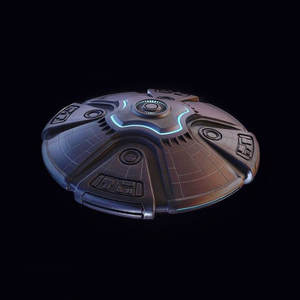
The Spacial Variance Reactor is an advanced energy system that extracts usable power from a stabilized artificial 1-brane—an engineered one-dimensional structure embedded within layered subspace and local spacetime curvature. It produces short-duration, high-intensity energy bursts and regenerates passively through field dynamics.
Design
The core of the reactor consists of a compact, tensioned 1-brane suspended across multiple subspace strata and anchored to local spacetime geometry. This brane stores unified energy in a low-entropy, high-tension configuration. The reactor initiates controlled energy release by exploiting the tension differential between the brane and its surrounding spacetime.
As the brane begins to relax, it produces dimensional disturbances that generate verteron particles—virtual-like mediators of energy transfer. These emissions are routed through a series of accelerator coils, which extract usable power from the cascading recoil of subspace layers responding to the brane’s energetic discharge. The verterons themselves are not a power source; rather, their flux indicates active brane-spacetime interaction.
The brane is not depleted in the traditional sense; instead, energy output ceases temporarily when the local spacetime region reaches equilibrium with the brane. Once the gradient reforms due to cooling, vacuum fluctuation, or external influence, the brane re-tensions and becomes active again.
Operation
In practical use, the Spacial Variance Reactor operates in energetic cycles, delivering power in high-intensity bursts while the tension gradient between the 1-brane and local spacetime remains steep. As the energy differential flattens—corresponding to a rise in local spacetime entropy—verteron activity subsides and energy extraction halts.
Maximum power output depends on both the steepness of the tension gradient and the rate at which energy is drawn. The reactor can produce extremely high output in very short bursts, but such operation is inherently unstable. Rapid extraction collapses the gradient quickly, initiating a dormancy cycle as the local region approaches entropic saturation.
Operators can moderate energy draw to preserve the brane's tension differential, extending the reactor’s active phase. While this reduces peak power, it increases operational stability and usable runtime. Once activated, the reactor cannot be conventionally shut down; it remains active until the gradient depletes and must passively regenerate over time.
Due to the burst-based nature of energy output, the reactor should be coupled with an energy storage and regulation system to buffer power delivery. This ensures consistent output to systems despite the reactor's cyclic energy profile.
Reactors must be spaced appropriately to avoid subspace interference. Clustering units closer than 35–38 mm risks destabilizing the local gradient fields, potentially leading to resonance interference or micro-rift formation.
Power Characteristics
- **Extremely high power density**, capable of brief ultra-intense output. - **Power bursts are unstable**, leading to rapid entropy equalization if not moderated. - **Output declines steeply** as local spacetime reaches energetic parity with the brane. - **Longer active periods possible** via reduced draw, trading intensity for duration. - **Passive regeneration** when local field conditions return to low-entropy states.
Size Limitations
Larger-scale variants are limited by geometric and field instability. As the reactor increases in scale, the internal structure becomes increasingly difficult to construct and maintain. Attempts to form a stable 1-brane at larger dimensions result in cascading complexity—substructures and higher-dimensional distortions emerge within the brane itself, disrupting uniform tension and reducing efficiency. Small reactors are preferred due to their high tension retention, regenerative efficiency, and controllable energy discharge characteristics.
Major Components
- Brane Core Assembly
- Contains the stabilized artificial 1-brane suspended across dimensional anchors; the primary source of energy potential.
- Containment Field Housing
- Maintains spatial isolation and dimensional pressure control around the brane core to preserve structural tension and prevent premature energy bleed.
- Subspace Interface Manifold
- Regulates the alignment between the brane core and adjacent subspace layers, enabling controlled energy transfer through field resonance.
- Verteron Induction Coils
- Detect and channel verteron particle flux generated by brane-spacetime interactions, directing them into the conversion systems.
- Energy Conversion Matrix
- Converts subspace recoil and verteron flux into usable electrical or plasma output based on application requirements.
- Thermal Stabilizer Unit
- Manages localized heat buildup caused by energy release cycles, maintaining safe operating temperatures within the reactor housing.
- Gradient Monitoring Array
- Continuously measures spacetime tension differential and entropy levels to regulate output and predict dormancy phases.
- Phase Modulator
- Adjusts the rate of energy extraction and helps shape the output curve by manipulating field harmonics and brane tension damping.
- Containment Shield Lattice
- Provides structural reinforcement and protects surrounding systems from dimensional feedback or containment field failure.